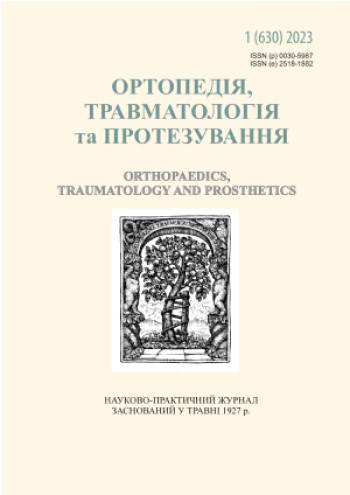PREDICTORS OF FRACTURES IN PATIENTS WITH STAGE VD CHRONIC KIDNEY DISEASE TREATED WITH HEMODIALYSIS
DOI:
https://doi.org/10.15674/0030-59872023118-24Keywords:
Predictors of fractures, kidneys, hemodialysis, laboratory parametersAbstract
Bone pathology begins in the early stages of chronic kidney disease (CKD), but clinical consequences — bone pain and fractures — occur mainly at stage 5 of the disease (VD) in patients who use methods renal replacement therapy. Objective. To find out the frequency, localization and possible predictors of fractures in patients with CKD VD stage on the background of hemodialysis according to the results of a prospective study. Methods. 254 patients
were included in the cohort prospective open study with CKD VD stage, which was treated with hemodialysis hemodialysis during 2018‒2022. The study was conducted in two stages. On the first, based on the analysis of medical documentation, received data on the presence of fractures of all localizations, diabetes, hypertension, secondary hyperparathyroidism, hyperhydration, type of initial vascular access, eKt/V, body mass index (IMT), peripheral vascular disease. At the second stage, a prospective study of new cases of fractures was conducted. Results. Examined72 (32.3 %) women and 151 (67.7 %) men, average age — (49.4 ± 14.03) years — did not differ significantly depending on gender (p = 0.1088). The most frequent cause of CKD stage VD was glomerulonephritis — 111 patients (49.77 %). At the time of the beginning of observation, 30 cases were ascertained fractures in 26 patients, and at the end — 62 in 51 patients. By the results of univariate Cox regression analysis it was established that independent predictors of occurrence new fractures are the patientʼs age, female gender, smoking, presence of peripheral vascular diseases, BMI, as well as serum albumin, parathyroid hormone, calcium, phosphorus, alkaline phosphatase, and vitamin D levels. Conclusions. The developed method of fracture risk assessment for patients with CKD VD stage on the background of hemodialysis is individualized, accessible in execution and interpretation, allows to distinguish patients with increased risk the occurrence of fractures with the help of standard bases clinical and laboratory indicators.
References
- Dey, V., Farrah, T. E., Traynor, J. P., Spalding, E. M., Robertson, S. E., & Geddes, C. C. (2016). Symptomatic fracture risk in the renal replacement therapy population. Nephrology Dialysis Transplantation, gfw222. doi:10.1093/ndt/gfw222
- Kim, Y., Lee, E., Lee, M., Park, B., & Park, I. (2022). Characteristics of fracture in patients who firstly starts kidney replacement therapy in Korea: A retrospective population-based study. Scientific Reports, 12(1). doi:10.1038/s41598-022-07178-4
- Tentori, F., McCullough, K., Kilpatrick, R. D., Bradbury, B. D., Robinson, B. M., Kerr, P. G., & Pisoni, R. L. (2014). High rates of death and hospitalization follow bone fracture among hemodialysis patients. Kidney International, 85(1), 166–173. https://doi.org/10.1038/ki.2013.279
- Kwon, Y. E., Choi, H. Y., Kim, S., Ryu, D., & Oh, H. J. (2019). Fracture risk in chronic kidney disease: A Korean population-based cohort study. Kidney Research and Clinical Practice, 38(2), 220-228. doi:10.23876/j.krcp.18.0099
- Antomonov, M. Yu. (2018). Mathematical processing and analysis of biomedical data. Kyiv: Mediinform. (in russian)
- Dudar, S. L. (2021). Fractures in patients with chronic kidney disease. Ukrainian journal of nephrology and dialy¬sis, 71 (2), 88‒96. doi: 10.31450/ ukrjnd.3(71).2021.10.
- Kazama, J. J. (2016). Chronic kidney disease and fragility fracture. Clinical and Experimental Nephrology, 21(S1), 46-52. doi:10.1007/s10157-016-1368-3
- Fusaro, M., Tripepi, G., Noale, M., Vajente, N., Plebani, M., Zaninotto, M., … Gallieni, M. (2013). High prevalence of vertebral fractures assessed by quantitative Morphometry in hemodialysis patients, strongly associated with vascular calcifications. Calcified Tissue International, 93(1), 39-47. doi:10.1007/s00223-013-9722-x
- Mahjoub, Z., Jean, S., Leclerc, J., Brown, J. P., Boulet, D., Pelet, S., … Michou, L. (2016). Incidence and characteristics of atypical femoral fractures: Clinical and geometrical data. Journal of Bone and Mineral Research, 31(4), 767-776. doi:10.1002/jbmr.2748
- Jadoul, M., Albert, J., Akiba, T., Akizawa, T., Arab, L., Bragg-Gresham, J., … Pisoni, R. (2006). Incidence and risk factors for hip or other bone fractures among hemodialysis patients in the dialysis outcomes and practice patterns study. Kidney International, 70(7), 1358-1366. doi:10.1038/sj.ki.5001754
- Stenvinkel, P., Carrero, J. J., Von Walden, F., Ikizler, T. A., & Nader, G. A. (2015). Muscle wasting in end-stage renal disease promulgates premature death: Established, emerging and potential novel treatment strategies. Nephrology Dialysis Transplantation, 31(7), 1070-1077. doi:10.1093/ndt/gfv122
- Bover, J., Ureña, P., Aguilar, A., Mazzaferro, S., Benito, S., López-Báez, V., … Cozzolino, M. (2018). Alkaline Phosphatases in the complex chronic kidney disease-mineral and bone disorders. Calcified Tissue International, 103(2), 111-124. doi:10.1007/s00223-018-0399-z
- Shifris, I. M. (2020). Diabetic status, comorbidit y and survival in patients with chronic kidney dise ase stage VD st.: a cohort study. Problems of Endocrine Pathology, 72(2), 95-103. doi: 10.21856/j-PEP.2020.2.12
Downloads
How to Cite
Issue
Section
License

This work is licensed under a Creative Commons Attribution 4.0 International License.
The authors retain the right of authorship of their manuscript and pass the journal the right of the first publication of this article, which automatically become available from the date of publication under the terms of Creative Commons Attribution License, which allows others to freely distribute the published manuscript with mandatory linking to authors of the original research and the first publication of this one in this journal.
Authors have the right to enter into a separate supplemental agreement on the additional non-exclusive distribution of manuscript in the form in which it was published by the journal (i.e. to put work in electronic storage of an institution or publish as a part of the book) while maintaining the reference to the first publication of the manuscript in this journal.
The editorial policy of the journal allows authors and encourages manuscript accommodation online (i.e. in storage of an institution or on the personal websites) as before submission of the manuscript to the editorial office, and during its editorial processing because it contributes to productive scientific discussion and positively affects the efficiency and dynamics of the published manuscript citation (see The Effect of Open Access).














